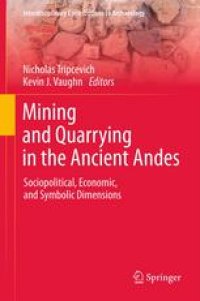
Ebook: Mining and Quarrying in the Ancient Andes: Sociopolitical, Economic, and Symbolic Dimensions
- Genre: History
- Tags: Archaeology, Anthropology, Mineral Resources
- Series: Interdisciplinary Contributions to Archaeology
- Year: 2013
- Publisher: Springer-Verlag New York
- Edition: 1
- Language: English
- pdf
Over the millennia, from stone tools among early foragers to clays to prized metals and mineral pigments used by later groups, mineral resources have had a pronounced role in the Andean world. Archaeologists have used a variety of analytical techniques on the materials that ancient peoples procured from the earth. What these materials all have in common is that they originated in a mine or quarry. Despite their importance, comparative analysis between these archaeological sites and features has been exceptionally rare, and even more so for the Andes. Mining and Quarrying in the Ancient Andes focuses on archaeological research at primary deposits of minerals extracted through mining or quarrying in the Andean region. While mining often begins with an economic need, it has important social, political, and ritual dimensions as well. The contributions in this volume place evidence of primary extraction activities within the larger cultural context in which they occurred. This important contribution to the interdisciplinary literature presents research and analysis on the mining and quarrying of various materials throughout the region and through time. Thus, rather than focusing on one material type or one specific site, Mining and Quarrying in the Ancient Andes incorporates a variety of all the aspects of mining, by focusing on the physical, social, and ritual aspects of procuring materials from the earth in the Andean past.
From stone for building to metal ores for ceremonial display, extracting mineral resources from the earth played a central role in ancient Andean civilizations. Despite this, the sites that supported these activities have rarely been a source of interest to archaeologists, and comparative analysis between mines and quarries and their features has been exceedingly rare.
Mining and Quarrying in the Ancient Andes focuses on the primary extraction of a variety of materials that, in many cases, were used by cultures like the Inca, Wari and Tiwanaku in well-studied sites. The book delves into the broader mining practices that link diverse materials for a fascinating tour of the social and economic life of the prehispanic period, and of ancient technologies, some of which are still in use. Through the politics of the societies, the practical engineering issues of mineral extraction, and the symbolic nature of the locations, readers are given a broader context of mining and quarrying than is usually seen in the literature. Here, too, is a wide variety of sites, materials, and time periods, including:
- Technological and social aspects of obsidian procurement focusing on the Quispisisa source.
- Variation in Inca building stone quarry operations in Ecuador and Peru.
- Clay and temper mining practices in the Lake Titicaca Basin.
- Pigment extraction from Chile to southern Peru from the early Holocene through the Early Intermediate Period.
- The Huarhua rock salt mine: archaeological implications of contemporary salt extraction practices.
- Later pre-Hispanic (including Inca) mining with consideration of technical, ceremonial and political context.
- Shifts in architectural stone quarrying during state expansion at Tiwanaku
Mining and Quarrying in the Ancient Andes will find an interested audience among archaeologists, geologists, anthropologists, historians, researchers studying Latin America, and scholars in the physical sciences with an interest in the history of mining and how mining is embedded in the wider social realm.